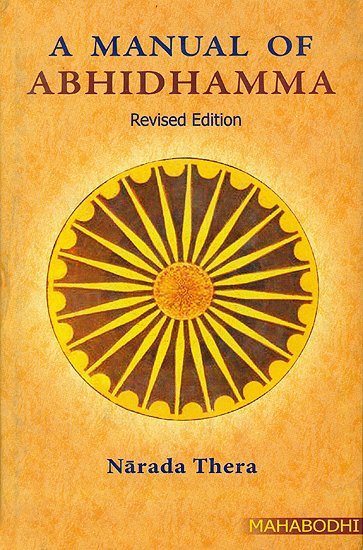A Manual of Abhidhamma
by Nārada Thera | 80,494 words | ISBN-13: 9789380336510
In the Abhidhammattha Sangaha there is a brief exposition of the Law of Dependent Origination, followed by a descriptive account of the Causal Relations that finds no parallel in any other philosophy. Edited in the original Pali Text with English Translation and Explanatory Notes by Narada Maha Thera....
§ 14.
-
Kāmāvacara-sobhanesu pana kusalesu tāva pathamadvaye Aññasamāna terasa cetasikā pañcavisati Sobhanacetasikā c'āti atthatimsa-dhammā sangaham gacchanti.
Appamañña Viratiyo pan'ettha pañca'pi paccekam'eva yojetabbā. - Tathā dutiyadvaye ñānavajjittā;
- tatiyadvaye ñānasampayuttā pītivajjitā;
- catutthadvaye ñānapītivajjitā. Te eva sangayhanti.
Kiriyacittesu'pi Virativajjitā. Tath'eva catusu'pi dukesu catudhā' va sangayhanti.
Tathā vipākesu ca Appamaññā-Virativajjitā. Te eva sangayhantī'ti sabbathā' pi catuvīsati kāmāvacarasobha-nacittesu dukavasena dvādasadhā'va sangaho hotī'ti.
§ 15.
Atthatimsa sattatimsa - dvayam chattimsakam subhe
Pañcatimsa catuttimsa - dvayam tettimsakam kriye
Tettimsa pāke dvattimsa - dvayekatimsa karm bhave
Sahetukāmāvacara - puññapākakriyā mane
§ 16.
Na vijjant'ettha virati - kriyāsu ca mahaggate
Anuttare appamaññā - kāmapāke dvayam tathā
Anuttare jhānadhammā - appamaññā ca majjhime
virati ñāna-pīti ca - parittesu visesakā.
(translation)
§ 14.
-
At first, in the first two (types of) Sense-Sphere Beautiful consciousness[1] thirty-eight states go into combination - namely, thirteen miscellaneous and twenty-five Beautiful mental states. (13 + 25 = 38)
The two Illimitables and the three Abstinences should be fitted in severally.[2] - Similarly in the second couplet all of them arise excluding Wisdom;
- in the third couplet, associated with Wisdom, Joy is excluded;
- in the fourth couplet Wisdom and Joy[3] are excluded.
In the Functional consciousness the three Abstinences are excluded.[4] Likewise in the four couplets they are combined in four ways.
Similarly in the Resultant consciousness they all arise except the Illimitables and the Abstinences.[5]
Thus in all the twenty-four types of Sense-sphere Beautiful types of consciousness the combination is twelve-fold according to pairs.
§ 15.
With respect to Sense-Sphere consciousness with roots -Moral, Resultant, and Functional - there arise in the Moral (first pair) thirty-eight, twice[6] thirty-seven (in the second and third pairs), and thirty-six( in the fourth pair). In the Functional thirty-five (in the first pair), twice thirty-four (in the second and third pairs), thirty three (in the forth pair). In the Resultant thirty three (in the first pair), twice thirty-two (in the second and third pairs), thirty-one (in the fourth pair).
§ 16.
Herein the Abstinences are not present in the Functional and Sublime consciousness.[7] So are Illimitables in the Supramundane and the two Illimitables and Abstinences) in the Sense-Resultants. (Note 54)
In the Highest the Jhāna factors are distinctive[8]; in the Middle (rūpāvacara and arūpāvacara), the Illimitables (and Jhāna factors[9]); in the Small (kāmāvacara), the Abstinences, Wisdom and Joy.
Footnotes and references:
[1]:
i.e., Somanassasahagatanāpasampayutta asankhārika and sasankhārika citta - Prompted and unprompted consciousness, accompanied by pleasure, and associated with wisdom.
[2]:
Because they are not fixed adjuncts. They arise at different moments of conscious experience.
[3]:
Being accompanied by upekkhā.
[4]:
Because the Arahats have completely eradicated the Abstinences.
[5]:
Illimitables do not arise because they have limitless beings as the objects, while the Resultants are restricted to lesser objects. The Abstinences are absolutely moral. Hence they do not arise in a resultant consciousness. In the Supramundane Fruit consciousness they however arise because it is like a reflection of the Path consciousness.
[6]:
i.e., thirty-seven in each of the second and third couplets.
[7]:
i.e. in the rūpāvacara arūpāvacara planes. Because no occasion arises for such evil to spring up.
[8]:
The supramundane consciousness, when classified according to five Jhānas, differs with respect to Jhāna factors.
[9]:
Ca in the text includes Jhāna factors.
[10]:
Morals differ from Resultants and Functionals on account of Abstinences. Morals and Functionals differ from Resultants on account of Illimitables. Respective couplets differ on account of Wisdom and Joy.
